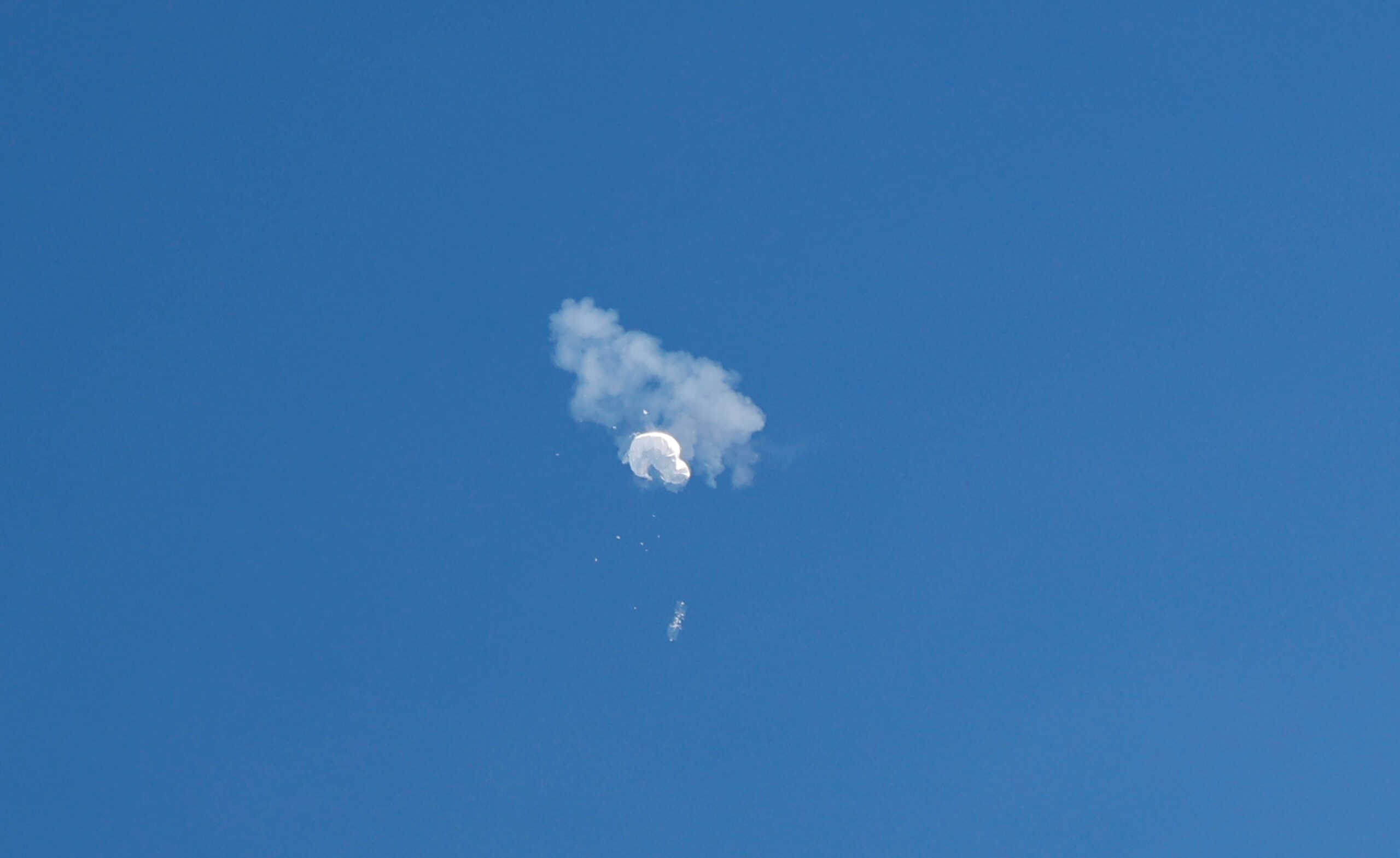By Randall Hill, Phil Stewart and Jeff Mason
SURFSIDE BEACH, S.C., Feb 4 (Reuters) – A U.S. military fighter jet shot down a suspected Chinese spy balloon off the coast of South Carolina on Saturday, a week after it first entered U.S. airspace and triggered a dramatic — and public — spying saga that worsened Sino-U.S. relations.
President Joe Biden said he had issued an order on Wednesday to take down the balloon, but the Pentagon had recommended waiting until it could be done over open water to safeguard civilians from debris crashing to Earth from thousands of feet (meters) above commercial air traffic.
“They successfully took it down, and I want to compliment our aviators who did it,” Biden said.
Multiple fighter and refueling aircraft were involved in the mission, but only one — an F-22 fighter jet from Langley Air Force Base in Virginia — took the shot at 2:39 p.m. (1939 GMT), using a single AIM-9X supersonic, heat-seeking, air-to-air missile, a senior U.S. military official said.
China strongly condemned the military strike on an airship that it says was used for meteorological and other scientific purposes, and which it said had strayed into U.S. airspace “completely accidentally” — claims flatly dismissed by U.S. officials.
Read Also: China Will Use Antarctica For Its Ocean Monitoring Satellites
“China had clearly asked the U.S. to handle this properly in a calm, professional and restrained manner,” China’s foreign ministry said in a statement. “The U.S. had insisted on using force, obviously overreacting.”
The balloon was shot down about six nautical miles off the U.S. coast of the Atlantic Ocean, over relatively shallow water, potentially aiding efforts to recover elements of the Chinese surveillance equipment over the coming days, U.S. officials said.
One U.S. military official said the debris field was spread out over seven miles (11 km) of ocean, and multiple U.S. military vessels were on site.
The downing of the balloon came shortly after the U.S. government ordered a halt to flights in and out of three airports in South Carolina — Wilmington, Myrtle Beach and Charleston — due to what it said at the time was an undisclosed “national security effort.” Flights resumed on Saturday afternoon.
While Saturday’s shootdown concludes the military dimension to the spying saga, Biden is likely to continue to face intense political scrutiny from Republican opponents in Congress who argue he failed to act quickly enough.
A senior administration official said after shooting down the balloon, the U.S. government spoke directly with China about the action. The State Department also briefed allies and partners around the world, the official said.
Questions remain about how much information China may have gathered during the balloon’s trek across the United States.
The balloon entered U.S. airspace in Alaska on Jan. 28 before moving into Canadian airspace on Jan 30. It then re-entered U.S. airspace over northern Idaho on Jan. 31, a U.S. defense official said. Once it crossed over U.S. land, it did not return to open waters, making a shootdown difficult.
U.S. officials did not publicly disclose the balloon’s presence over the United States until Thursday.
“It’s clear the Biden administration had hoped to hide this national security failure from Congress and the American people,” said U.S. Representative Mike Rogers, a Republican who leads the House of Representatives Armed Services Committee.
Biden’s emphasis on Saturday that — days ago — he ordered the balloon shot down as soon as possible could be an effort to respond to such critics.
Former President Donald Trump, Biden’s potential rival in the 2024 election, called earlier this week for the balloon to be shot down, and has sought to portray himself as stronger than Biden on China. The U.S. relationship with China is likely to be a major theme of the 2024 presidential race.
Washington had called the balloon’s appearance a “clear violation” of U.S. sovereignty and notified Beijing about the shootdown on Saturday, a U.S. official said.
Still, officials on Saturday appeared to play down the balloon’s impact on U.S. national security.
“Our assessment — and we’re going to learn more as we pick up the debris — was that it was not likely to provide significant additive value over and above other (Chinese) intel capability, such as satellites in low-Earth orbit,” the senior U.S. defense official said.
A Reuters photographer who witnessed the shootdown said a stream came from a jet and hit the balloon, but there was no explosion. It then began to fall.
The Pentagon assesses that the balloon was part of a fleet of Chinese spy balloons. On Friday, it said another Chinese balloon was flying over Latin America.
“Over the past several years, Chinese balloons have previously been spotted over countries across five continents, including in East Asia, South Asia and Europe,” the U.S. official said.
The suspected spy balloon prompted Secretary of State Antony Blinken to postpone a visit to China this week that had been expected to start on Friday.
The postponement of Blinken’s trip, which had been agreed to in November by Biden and Chinese President Xi Jinping, was a blow to those who saw it as an overdue opportunity to stabilize an increasingly fractious relationship between the two countries.
China is keen for a stable U.S. relationship so it can focus on its economy, battered by the now-abandoned zero-COVID policy and neglected by foreign investors alarmed by what they see as a return of state intervention in the market.
(Reporting by Randall Hill in Surfside Beach, South Carolina, and Phil Stewart, Steve Holland, Jeff Mason and David Shepardson in Washington; Additional reporting by Ryan Woo in Beijing; Writing by Phil Stewart and Diane Bartz; Editing by Daniel Wallis, Marguerita Choy, Leslie Adler, Sandra Maler and William Mallard)
(c) Copyright Thomson Reuters 2023.

 Join The Club
Join The Club












